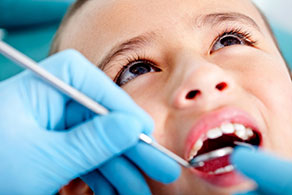 If your child is around the age of six or seven, then their adult teeth may have already begun emerging or should begin emerging soon. Like many parents, you may be excited that your child is reaching a new milestone in life, yet fearful that these teeth may have problems when they erupt.
If your child is around the age of six or seven, then their adult teeth may have already begun emerging or should begin emerging soon. Like many parents, you may be excited that your child is reaching a new milestone in life, yet fearful that these teeth may have problems when they erupt.
Thankfully, most children's permanent teeth erupt with few or no problems. However, you should learn about permanent tooth problems that can occur in children so that you know what dental problem your child may be experiencing and if the problem warrants the attention of a dentist. Read on to learn about four emerging-tooth concerns and how they are typically treated.
1. Yellow-Toned Teeth
Many parents notice that their children's permanent teeth appear yellow in color when compared to their primary teeth as they erupt. The good news is that this yellow tone is typically perfectly normal and typically no cause for alarm.
Adult teeth often appear slightly yellow in color when compared to primary teeth because adult teeth contain more yellow-toned dentin. This yellow-toned dentin is slightly visible through translucent white tooth enamel, which is why adult teeth are rarely bright white naturally. Since primary teeth are typically very white, the slightly yellow tone of a child's adult teeth can appear very yellow in comparison even when they are not. Typically, no treatment is necessary for this issue.
2. Non-Emerging Teeth
Just as a child's primary teeth typically erupt in a specific order that does not vary much from child to child, adult teeth also typically emerge in a specific order. Typically, your child's first permanent molars or central incisors erupt first when your child is around the age of six. Next, your child's permanent lateral incisors and canine teeth will erupt, followed by two sets of premolars, and, finally, their final set of molars.
If you find that a specific tooth does not emerge when expected, then this may concern you. There are many reasons that an adult tooth may not erupt on time or at all. The most common cause of an adult tooth that does not erupt is a lack of space in the mouth for this tooth.
This can occur when the area the tooth should occupy is already occupied by adult teeth that erupted slightly out of place or a jaw that is too narrow to accommodate this tooth. However, a permanent tooth may also be impacted behind a primary tooth that refuses to fall out or another blockage, such as a cyst.
These eruption problems can be detected by your dentist with a simple x-ray. Your dentist may then decide to treat the problem on their own or suggest orthodontic treatment.
3. Discolored Patches on Teeth
Some parents feel alarmed if their child's teeth emerge with patches of discoloration on them. These patches of discoloration can be white, brown, or yellow in appearance, and they can affect all permanent teeth or just some of them. While there are other causes of discolored permanent teeth, these discolorations are often caused by a condition called enamel hypoplasia.
Enamel hypoplasia has many causes, including genetics, medications, illnesses, and diseases that may have affected your child while in the womb or during early childhood. While some teeth that are affected by enamel hypoplasia are simply discolored, others can have weak, thin enamel that can easily break or develop decay.
Take your child to the dentist to determine the cause of the discolored patches on your child's teeth. If your child is diagnosed with enamel hypoplasia, your child's dentist may provide fluoride treatments to strengthen weak tooth enamel and then disguise tooth discolorations with dental resin or dental crowns.
4. Impacted Teeth
If your child has an adult tooth that emerged behind a baby tooth that never fell out, then this is no cause for alarm. Typically, an adult tooth dissolves the root of a baby tooth as it replaces it. However, when an adult tooth erupts behind a baby tooth, the root of the baby tooth often does not dissolve, which leads to this tooth staying in place longer than necessary.
Sometimes, a slightly over-retained baby tooth will fall out on its own within the first several weeks after a permanent tooth emerges. However, if it does not fall out on its own, visit your dentist. They can determine why the baby tooth is still in place and whether it should be extracted or not. Surprisingly, a permanent tooth often naturally shifts into proper position after the baby tooth in front of it falls out on its own or is extracted.
If your child's permanent teeth have just begun emerging or you expect them to emerge soon, then keep these four emerging adult tooth concerns and their causes in mind to determine whether your child's dentist should be alerted to your child's permanent tooth problem immediately or not.
Also, be sure to take your child to the dentist every six months for their regular dental exams so your dentist can check for any problems with your child's permanent tooth development you may not notice on your own. Contact the staff at Dentistry for Children & Adolescents to schedule your child's next dental exam today.